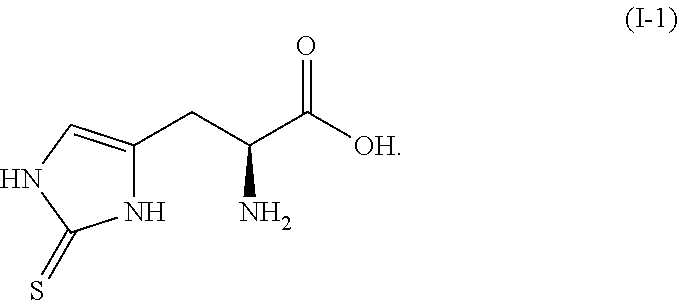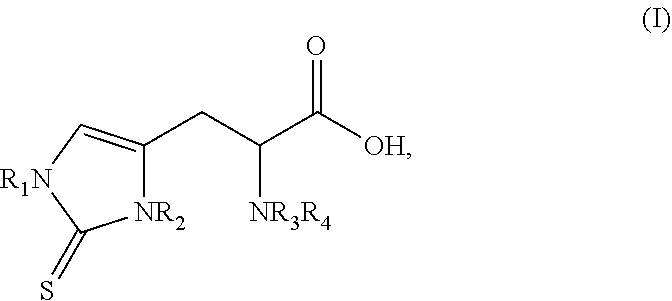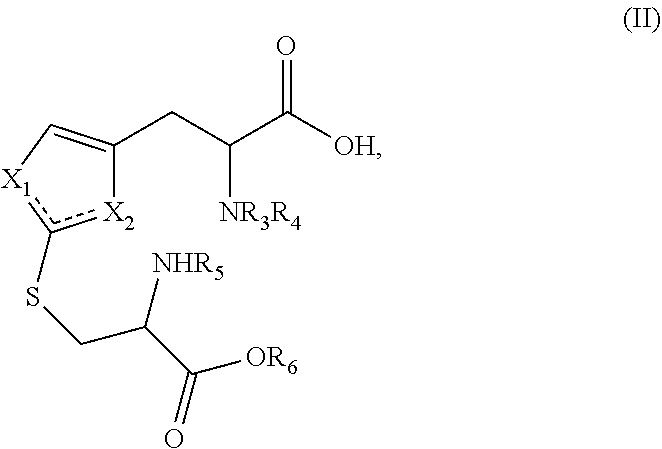Method for the synthesis of 2-thiohistidine and the like
a thiohistidine and synthesis method technology, applied in the field of new methods, can solve the problems of high toxicity of kscn, difficult to obtain large quantities of kscn, and difficulty in obtaining a large quantity of kscn, and achieve the effect of facilitating subsequent purification of the compound and being more ecological
- Summary
- Abstract
- Description
- Claims
- Application Information
AI Technical Summary
Benefits of technology
Problems solved by technology
Method used
Image
Examples
example 1
Preparation of 2-{2-[(2-ammonio-2-carboxyethyl)thio]-1H-imidazol-4-yl}-1-carboxy-ethanaminium dihydrochloride (His-Cys, 2HCl)
[0076]
[0077]1.57 g (7.5 mmol) of L-histidine hydrochloride monohydrate is dissolved in 15 ml of water and the solution is cooled at 0° C. Under very strong stirring, 500 μl (1.56 g, 9.75 mmol, 1.3 eq) of bromine is added dropwise (addition time: 2 min 10 sec). The reaction mixture turns yellow. Three minutes after the end of the addition of bromine, 2.81 g (22.5 mmol, 3 eq) of L-cysteine is added. Immediately, the mixture loses its color. After stirring at 0° C. for 1 hour, the mixture is filtered and the precipitate is washed with 2×0.5 ml of water.
[0078]The filtrate is deposited on a column filled with 75 g of Dowex® 50WX2-400, conditioned beforehand with 1 N hydrochloric acid (HCl). After elution with 750 ml of 1 N hydrochloric acid and then 500 ml of 2 N hydrochloric acid, the fractions containing the desired product are combined. After evaporation and two...
example 2
Preparation of 2-{2-[2-ammonio-2-carboxyethyl)thio]-1H-imidazol-4-yl}-1-carboxy-N,N-dimethylethanaminium dihydrochloride (HisNMe2-Cys, 2HCl)
[0081]
[0082]4.753 g (20 mmol) of N,N-dimethylhistidine hydrochloride monohydrate (V. N. Reinhold et al., J. Med. Chem. 11, 258 (1968)) is dissolved in 40 ml of water and the solution is cooled at 0° C. Under very strong stirring, 1.23 ml (3.835 g, 24 mmol, 1.2 eq) of bromine is rapidly added dropwise (addition time: 1 min 20 sec), without exceeding 2° C. The reaction mixture turns yellow and a reddish solid is formed. Seven minutes after the end of the addition of bromine, all the red solid dissolves and then 7.417 g (60 mmol, 3 eq) of L-cysteine is added. Immediately, the mixture loses its color. After stirring at 0° C. for 1 hour, a white suspension is obtained. The mixture is filtered and the precipitate is washed with 2×2 ml of water.
[0083]The filtrate is deposited on a column filled with 100 g of Dowex® 50WX2-400, conditioned beforehand wit...
example 3
Preparation of 2-{2-[(2-ammonio-2-carboxyethyl)thio]-1H-imidazol-4-yl}-1-carboxy-N-methylethanaminium dihydrochloride (HisNHMe-Cys, 2HCl)
[0086]
[0087]1.187 g (5.656 mmol) of α-N-methylhistidine hydrochloride (V. N. Reinhold et al., J. Med. Chem. 11, 258 (1968)) is dissolved in 11.3 ml of demineralized water. The solution is cooled at 0° C. and 377 μl (1.175 g, 7.353 mmol, 1.3 eq) of bromine is added dropwise under very strong stirring (addition time: 1 min 45 sec). The reaction mixture turns yellow and the temperature increases to 4° C.
[0088]Three minutes after the end of the addition of bromine, 2.119 g (16.96 mmol, 3 eq) of L-cysteine is added. Immediately, the mixture loses its color. After stirring at 0° C. for 1 hour, the mixture is deposited on a column filled with 50 g of Dowex® 50WX2-400, conditioned beforehand with 0.5 N hydrochloric acid. After elution with 250 ml of 0.5 N hydrochloric acid and then 250 ml of 1 N hydrochloric acid and 500 ml of 1.5 N hydrochloric acid, the ...
PUM
| Property | Measurement | Unit |
|---|---|---|
| temperature | aaaaa | aaaaa |
| temperature | aaaaa | aaaaa |
| temperature | aaaaa | aaaaa |
Abstract
Description
Claims
Application Information
 Login to View More
Login to View More - R&D
- Intellectual Property
- Life Sciences
- Materials
- Tech Scout
- Unparalleled Data Quality
- Higher Quality Content
- 60% Fewer Hallucinations
Browse by: Latest US Patents, China's latest patents, Technical Efficacy Thesaurus, Application Domain, Technology Topic, Popular Technical Reports.
© 2025 PatSnap. All rights reserved.Legal|Privacy policy|Modern Slavery Act Transparency Statement|Sitemap|About US| Contact US: help@patsnap.com



